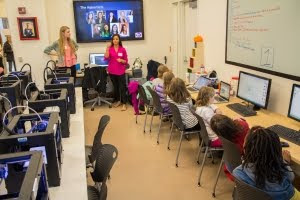The University of Illinois in Urbana-Champaign Makerlab is the world’s first on-campus Business School 3D Printing Lab, with sixteen Makerbot Replicator 2 printers available for use. But if you look through the door of this lab on a Monday night, it might not be college students you see hard at work designing and printing, but a group of 7-10 year old MakerGirls. Founded by three Illinois students, Lizzy Engele, Sophie Li, and Julia Haried, MakerGirl has set out to empower young girls to become leaders in STEM fields through 3D Printing, creative activities, and a presentation on women who have made contributions in STEM fields.
As a part of her business classes and internships, Co-Founder Julia Haried “noticed an inequality in C-Suite positions in STEM, with very few women in these roles.” While women make up almost half of the American workforce, only about 14% of STEM career roles are held by women. Fewer than 60% of girls have met a woman in a science, technology, engineering or math career. “While we knew we couldn’t have an immediate and direct impact at the C-Suite level (CEO, COO, etc.), we saw an opportunity to make an impact starting with younger girls”, says Julia.
MakerGirls learn to use software to design their projects for 3D Printing
A MakerGirl is hard at work on the designing phase of her project
According to Julia, MakerGirl chose 3D Printing as a way to get girls excited about STEM by highlighting a technology that is creative, on trend, and has the potential to revolutionize many industries. The printers are safe for kids and easy to operate, and the lab itself is “an amazing and valuable resource” to do so. Makergirl is not focused solely on the girls though, but also in helping parents to continue making STEM exciting at home by providing additional material to make learning a family-oriented and ongoing adventure. According to the US Bureau of Labor Statistics, the United States will need to fill 1.7 million job openings in Science, Technology, Engineering, and Mathematics (STEM) careers between 2012 and 2022 due to growth and replacement needs. While this is good news for both recent graduates and current students, it also provides parents an incredible opportunity to support and encourage their children’s interest in STEM classes and careers. “It’s important to get men to support this change as well”, adds Julia.
During a MakerGirl session, each girl has an opportunity to use the computers to design a project for herself and see it created on the 3D Printer. Projects have included bracelets, hair barrettes, and printed name magnets. As a part of the session, the girls also have an opportunity to interact with the lead engineers, typically female faculty members or engineering students, who talk to the girls about the contributions of women such as Marita Cheng (Founder of 2Mar Robotics), Marie Curie (Physicist, Chemist, and Nobel Prize Winner), Bessie Coleman (Aviator), and Ada Lovelace (Mathematician). The girls also get to learn about different career options available in STEM fields.
MakerGirls learn about the contributions of women in STEM fields
Sessions at MakerGirl have sold out within hours of being opened for registration, with a cost of $15 per session. As summer vacation approaches, MakerGirl hopes to quadruple the number of students able to attend sessions. The group is also on track to obtain 501(c)(3) status, with the goal in mind of partnering with other Universities to bring MakerGirl to campuses across the country. While MakerGirl can be modified to fit the resources of schools, the program is also looking down the road to obtaining and modifying a truck to take MakerGirl mobile. With a vehicle full of 3D Printer stations and computers, MakerGirl could have the potential to travel to elementary schools and colleges across the country to hold 3D Printing sessions on-site. According to Julia, “It’s a goal of ours, to have several trucks available across the country and share MakerGirl.”

























